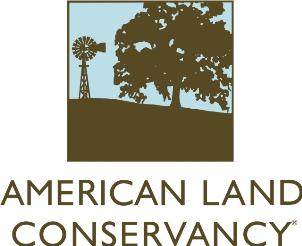
In the United States, a conservation easement is a power invested in a qualified land conservation organization called a "land trust", or a governmental entity to constrain, as to a specified land area, the exercise of rights otherwise held by a landowner so as to achieve certain conservation purposes. It is an interest in real property established by agreement between a landowner and land trust or unit of government. The conservation easement "runs with the land", meaning it is applicable to both present and future owners of the land. The grant of conservation easement, as with any real property interest, is part of the chain of title for the property and is normally recorded in local land records.
Land trusts are nonprofit organizations which own and manage land, and sometimes waters. There are three common types of land trust, distinguished from one another by the ways in which they are legally structured and by the purposes for which they are organized and operated:

The American Battlefield Trust is a charitable organization whose primary focus is in the preservation of battlefields of the Revolutionary War, the War of 1812, and the American Civil War, through the acquisition of battlefield land. The American Battlefield Trust was formerly known as the Civil War Trust. On May 8, 2018, the organization announced the creation of the American Battlefield Trust as the umbrella organization for two divisions, the Civil War Trust and the Revolutionary War Trust, which was formerly known as "Campaign 1776".

Conservation development, also known as conservation design, is a controlled-growth land use development that adopts the principle for allowing limited sustainable development while protecting the area's natural environmental features in perpetuity, including preserving open space landscape and vista, protecting farmland or natural habitats for wildlife, and maintaining the character of rural communities. A conservation development is usually defined as a project that dedicates a minimum of 50 percent of the total development parcel as open space. The management and ownership of the land are often formed by the partnership between private land owners, land-use conservation organizations and local government. It is a growing trend in many parts of the country, particularly in the Western United States. In the Eastern United States, conservation design has been promoted by some state and local governments as a technique to help preserve water quality.
American Farmland Trust (AFT) is a non-profit organization in the United States with a mission to protect farmland, promote environmentally sound farming practices, and keep farmers on the land. AFT is staffed by farmers, policy experts, researchers, and scientists, and governed by a board of directors. Its headquarters are in Washington, D.C., and it has regional offices throughout the country. AFT also runs the Farmland Information Center, an online collection of information on farmland and ranchland protection and stewardship established as a public-private partnership with the USDA Natural Resources Conservation Service.

Oatlands Historic House and Gardens is an estate located in Leesburg, Virginia, United States. Oatlands is operated by the National Trust for Historic Preservation and is listed on the National Register of Historic Places as a National Historic Landmark. The Oatlands property is composed of the main mansion and 415 acres of farmland and gardens. The house is judged one of the finest Federal period country estate houses in the nation.

The American Land Conservancy was an American non-profit organization whose goal was to protect the natural environment.
The Agriculture Retention and Development Act was created as part of New Jersey's efforts to counteract the loss of farmland in the state. The legislation formed the basis needed for the state to purchase the easements of New Jersey farms in order to ensure they remain as farms, and could never be sold for housing or for non-farming commercial development. The effect was to slow farmland loss in the state. The farmland preservation efforts made in New Jersey have effectively kept the farms as private land with a public legacy of permanent farm status. As of July 2022, New Jersey has permanently preserved 2,800 farms covering 247,517 acres.

Utah Open Lands Conservation Association is a 501(c)(3) nonprofit land trust conservation association in the United States.

Slocum's River Reserve is a 47-acre (19 ha) open space preserve co-managed by the land conservation non-profit organizations The Trustees of Reservations and The Dartmouth Natural Resources Trust. The property includes 3,000 feet (910 m) of frontage along the tidal Slocum's River in Dartmouth, Massachusetts, 2 miles (3.2 km) of trails, woodland, agricultural fields, and pasture. The reserve is open to the public.
California Rangeland Trust is a conservation nonprofit organization founded in 1998. The Rangeland Trust claims to be the largest land trust in California, having conserved over 371,000 acres (1,500 km2) of rangeland on 90 ranches across 26 counties.
Farm and Ranch Lands Protection Program (FRPP) — The Natural Resources Conservation Service (NRCS) renamed the Farmland Protection Program (FPP) to the Farm and Ranch Lands Protection Program in 2003 to accurately reflect the resources eligible to participate in the program. The program established by the 1996 farm bill to fund the purchase of conservation easements of 170,000-340,000 acres of land having prime or unique soil or other desirable production qualities that are threatened by urban development. Eligibility depends upon already having a pending offer from a state or local government to protect qualifying land by limiting nonagricultural use. The 2002 farm bill reauthorized the program through FY2007 and provided mandatory funding from the Commodity Credit Corporation (CCC) that was $50 million in FY2002 and will rise to $125 million in FY2004, then slowly decline to $97 million in FY2007. Other changes expanded the definition of eligible land to include cropland, rangeland, grassland, pasture land, incidental forest land, and historic and archeological sites; expanded the list of eligible participants to include Indian tribes and non profit organizations that meet specified qualifications; and directed an unspecified portion of the program funds to carry out a farm viability program. According to the NRCS FY2005 budget request document, more than 306,000 acres (1,240 km2) in 42 states have or soon will have easement contracts.

The Land Conservancy of San Luis Obispo County (LCSLO) is a non-profit land trust organization that has been operating in San Luis Obispo County, California since 1984. The LCSLO is dedicated to the voluntary and collaborative preservation and improvement of lands that hold significant scenic, agricultural, habitat, and cultural values. Their work aims to benefit both the local community and wildlife that depends on these lands.

The Agricultural Reserve is a designated land use zone in Montgomery County, Maryland. The 93,000 acres (380 km2) zone was created in 1980 by the Montgomery County Council to preserve farm land and rural space in the northwestern part of the county. The farmland protection program has been characterized as "the most famous, most studied and most emulated" program of its kind in the United States.
Joshua's Tract Conservation and Historic Trust, or Joshua's Trust, is a non-profit 501(c)(3) land trust operating in northeast Connecticut. Joshua's Trust was incorporated in 1966 to help conserve property of significant natural or historic interest. As of 2011, the Trust protects more than 5,000 acres, maintains 42 miles of trails that are open to the public, holds educational outreach programs, and publishes the Joshua's Tract Walkbook.
Preservation development is a model of real-estate development that addresses farmland preservation. It shares many attributes with conservation development, with the addition of strategies for maintaining and operating productive agriculture and silviculture, often in perpetuity. A preservation development is a planned community that allows limited, carefully designed development on a working farm, while placing the majority of productive land under a system of easements and community governance to ensure a continuity of farming and environmental stewardship.
Scenic Hudson is a non-profit environmental organization in New York that was founded in 1963 to oppose a hydro-electric power project in New York.

Agriculture played a major role in the early growth of Connecticut as one of the original 13 colonies that would form the United States of America, particularly in the Connecticut River valley which provides fertile soil, temperate climate and easy access to markets. As the Industrial Revolution helped focus capital on mercantile centers in the 19th century, Connecticut farmers over time ceded their relative economic and political influence.
The Land Trust for Tennessee is a non-profit conservation organization working to protect Tennessee's natural, scenic, and historic landscapes and sites. Since 1999, The Land Trust has conserved more than 135,000 acres (550 km2) of land across 65-plus Tennessee counties.

The Big Sur Land Trust is a private 501(c)(3) non-profit located in Monterey, California, that has played an instrumental role in preserving land in California's Big Sur and Central Coast regions. The trust was the first to conceive of and use the "conservation buyer" method in 1989 by partnering with government and developers to offer tax benefits as an inducement to sell land at below-market rates. Since 1978, with the support of donors, funders and partners, it has conserved over 40,000 acres through conservation easements, acquisition and transfer of land to state, county and city agencies. It has placed conservation easements on 7,000 acres and has retained ownership of over 4,000 acres.











